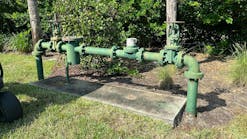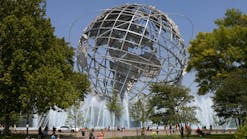Throughout the United States, economies of scale–and economy of budgets–are dictating that more subsurface detention systems be designed to accommodate not only these factors, but also environmental concerns for new development.
Consider the Sun Valley community in California’s San Fernando Valley region. This is an older area that has never been served by any sort of comprehensive storm drain system and has, over the years, been subject to flooding.
Los Angeles County has begun to view stormwater not as a city-by-city issue but as a watershed problem, says Curt Roth, an engineer with the Los Angeles division of CH2M Hill, headquartered in Denver, CO. Initially, the county considered alleviating the problem by building a multimillion-dollar storm drain system. But the community called for a more innovative solution that would enable the area to retain the water from stormwater runoff instead, directing it out into the ocean.
County officials developed a master plan for the Sun Valley Watershed, encompassing many options. CH2M Hill has been involved in the Sun Valley Park and Recreation Center project, the first “in ground” solution, which is part of the master plan. The infiltration project aims to alleviate chronic flooding in the area without taking up vital open space, as well as to reduce stormwater pollution and increase the groundwater supply.
“We’re taking the technology one step further,” says Roth. “Instead of holding onto the water, we’re going to be infiltrating it through the bottom of the unit. The main reason we are doing that is the soil is great for infiltrating. In fact, the county and the city both operate infiltration basins there in this same area.”
The project involves collecting water from a 25-acre area of residential homes into a small system of catch basins and storm drains, then running it to the park through an underground treatment system to remove solids and filtrate it through underground infiltration basins, recharging the depleting groundwater supply. The main reason CH2M Hill opted for an underground detention system is to avoid taking up park space. The system being underground also enables the community to make simultaneous and much-desired park improvements.
One alternative that had been considered consisted of a plastic structure set up like a stack of cups; water would flow through voids. “It could have been easily used, but there were several challenges to it specific to our site,” Roth says. “One, as deep as we needed to go, the plastic media couldn’t hold up to any sort of hard traffic. Two, while it was extremely light because it is recycled plastic, it was also very voluminous. We were looking at 150 truckloads of this stuff, because the basin is about an acre and a half. Shipping costs from the few places that manufacture it would have been horrendous.”
CH2M Hill chose StormTrap because the client preferred concrete. “They know concrete; they feel comfortable with it, and it provided the structural benefits we needed; plus it could be manufactured locally to reduce the shipping costs,” Roth says. By going with that option, the client saved about $600,000.
Although CH2M Hill planned to use an off-the-shelf system, modifications had to be made to accommodate design standards specific to Los Angeles County. “The size and configuration is standard–it’s all prefabricated and precast concrete–but they had to add a little bit more steel in the mix,” Roth says, adding that StormTrap contracts with a local concrete precast company to handle the fabrication and shipment.
Roth says the county is treating the project as a demonstration facility. Three additional manufacturers’ products are being used for treatment in an effort to ascertain which one best meets the claims of the product.
The solids separation devices being used are Vortechnics units and the Downstream Defender from Hydro International, as well as a StormFilter from Stormwater Management.
The upstream units are sized for a 50-year storm, and the StormFilter is sized to capture the first flush, at about a tenth of the 50-year design storm.
Roth says some other parts of the master plan call for significantly larger drainage areas and that this technology–depending on its performance–may be used in those applications as well. “It’s something we expect to see a lot more of,” he notes.
Meanwhile, a hospital in Faribault, MN, wanted to expand, but the Minnesota Pollution Control Agency required that, in areas where the space was insufficient to construct conventional stormwater management facilities, an alternative to reduce pollution and stormwater runoff be chosen.
The hospital board, the city’s engineering staff, and Sunde Engineering also determined conventional options would be expensive, given space considerations. Land would have to be acquired from surrounding residents for constructing stormwater detention ponds.
Sunde’s Michaelea Oeltjen, the project engineer, came up with a best management practice option using sections of precast concrete boxes for underground detention to be located under a portion of the parking lot and adjacent lawns that may eventually be tapped for more parking spaces.
Installed in 2004, the system, manufactured by Hancock Concrete Products, consists of 650 linear feet of 12- by 8-foot precast concrete box sections placed in five 130-foot-long parallel lines. The lines are spaced 8 feet apart and have connecting crossover ports of 36-inch-diameter precast concrete pipe to equalize the volume of the system between lines during heavy runoff periods. Fifteen- and 18-inch-diameter concrete pipe storm sewers provide inlets into the detention structure, and a 36-inch-diameter concrete pipe serves as the outlet control from the structure that discharges into a nearby ravine.
Each of the five lines was fitted with two access ports at the top of the structure for inspection and an orifice for inserting equipment to pump sediment from the detention system. The system was made watertight through bulkheads cast on the two end pieces of each line and a double wrap of joint mastic applied on all joint surfaces of the box sections. The project was the first of its kind for the contractor, Kraus-Anderson Construction. The company was able to install the system in three weeks.
Oeltjen sized the system according to the city’s rain control requirements based on predevelopment conditions and a state requirement of water volume. A 10-year and a 100-year storm design were used. Incorporated into the design was the fact that future development will result in more impervious surface.
“They are originally built as a box culvert,” Oeltjen says of the system. “We’ve used this type of underground box culvert in other situations and created permanent ground- and freshwater storage to let water go through. We also had a separate skimmer control structure that went in at the outlet of this system before it discharged into the ravine.”
Engineers sought a solution that would offer the most volume for permanency, and the 12- by 8-foot box did so, Oeltjen says. Other types of systems would not have provided the storage required at the lower elevations of the structure, she adds.
In Lombard, IL, in suburban Chicago, municipal officials approved a stormwater system at the reconstructed site of an old gas station–the Cove Mart Café convenience store–with this caveat: A mechanism had to be in place to ensure runoff was cleaned before it entered the municipal storm sewer system. The EPA’s National Pollutant Discharge Elimination System Phase II requirements change how municipalities look at new developments, municipal officials note.
Installed in September 2003, the system used at Cove Mart Café is a high-density polyethylene unit, the Storm Water Quality Unit manufactured by Hancor. Designed to reduce floating and suspended solids as well as hydrocarbons with its patented Baffle 55 separation device, the unit improves runoff quality from a localized area before the clean effluent is discharged to a storm sewer or receiving body of water.
Stormwater runoff collected from the site flows into catch basins and is discharged by gravity into a detention basin, and then goes to the Storm Water Quality Unit and is discharged into the municipal system, explains Jamil Bou-Saab, an engineer who serves as vice president of Terra Engineering.
The design for Cove Mart Café also includes an oil/water separator unit, the first installed in Lombard. “We are doing quality and quantity reduction,” Bou-Saab notes.
Bou-Saab says that while many options were considered, space constraints dictated what type of system could be used. His company specified the products for the site and favors similar systems for smaller sites. Bou-Saab says the system also is cost-effective.
“We were doing value engineering because it was a limited budget, and that’s the system we selected on the basis of the cost and the area we had,” he says. “There are other systems that would provide equal quality in cleaning stormwater runoff. For other applications, we might not use this system; we might use something else.”
Terra Engineering used a 100-year storm design in the project. Maximizing land use for parking and the turning grade was paramount in the design, Bou-Saab says. “It’s a very tight corner lot. We had to take into consideration having these trailer trucks deliver gas, and also there is a car wash, so in the detention pond we created, half of it is a retaining wall to maximize the detention area,” he says. “We used part of the wall of the building as a retaining wall so we can maximize everything.”
Since it’s relatively new in the ground, it’s too early to determine the system’s effectiveness, Bou-Saab points out. “We even looked at concrete or other materials for detention, so we did a lot of value engineering,” he says. “This one is unique because we have a combination for everything.”
Corporate Center Drive is a new road under construction near the Baltimore/Washington International Airport in Anne Arundel County in Maryland. A new Maryland Department of Transportation facility is being constructed there, and Corporate Center Drive serves as a connecting road between two other roads.
Paul Phillips, senior project manager at G.W. Stephens & Associates in Towson, MD, was charged with the task of finding underground storage for stormwater management in the design in an area that has no development at this point. The area is within distance of the Stony Run Watershed, located within wetlands that are of special state concern.
“Within this design, we needed to manage not only the one-year event, but the state required we manage the 100-year event also,” Phillip says. “For the water-quality management of that roadway, we utilized the side ditch grass swale, part of new regulations in Maryland.”
While the grass swale addressed water-quality management, the design also needed to address quantity management.
“Due to limited space and geometry of the roadway, we elected to go underground,” Phillips says, adding that there also could be future development at the site of a corporate park.
Based on existing runoff, the system that Phillips designed is made of corrugated steel located in a single underground pond. On the inflow end is a 12-foot-diameter corrugated pipe connected to the outflow end. In between are 380 feet of 12-foot-diameter pipe. Parallel to that is a 280-foot section of 11-foot-diameter pipe split between 10- and 11-foot diameter pipes. Also used are 250 feet of 10-foot-diameter pipe, all for stormwater storage.
As a rain event occurs, runoff discharges into the facility and is stored for a period of time, then sent out to a control structure that controls the flow to the outflow pipe. From there it proceeds through a section of storm drain, ultimately discharging into a tributary upstream in the Stony Run Watershed and into the wetlands.
Phillips considered concrete channels but found they weren’t cost-effective. “Corrugated steel is a less expensive product but essentially provided the same function and strength so that we could still put a parking lot on top of the storage facility,” he notes.





